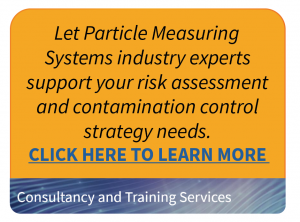About this Pharma Process
Powder filling is commonly associated with active pharmaceutical ingredients (API) where bulk powdered materials are filled into vessels prior to shipping to secondary processors. Employing the use of a Restricted Access Barrier System (RABS) enclosure will create a dust cloud so dense that a particle counter operating in that area becomes saturated and the data of no use. In addition, a lengthy purge cycle is required before using the particle counter again to monitor for contaminants.
Regulations around Powder Filling
Rules for powder filling have been issued by both the FDA and EU GMP standards. The EU GMP Annex 1 regulations state that monitoring should be routine with the sampling locations found via risk analysis. Grade A should be monitored for the entire process, except when damage to the particle counter may occur. This is corroborated by the FDA’s Sterile Drug Products Produced by Aseptic Processing guidance. It states that for cases that do not allow the measure of air quality (i.e., powder generation), sampling must be performed prior to operation. This sampling is used to gauge the product’s extrinsic exposure when operation occurs. You need to validate a process based on simulated operations and use that process at the beginning of each batch run.
Practical Application
Environmental control must be ensured by operators ‘pretending’ to fill actual bottles, bags, or other vessels. During simulation, in accordance to the normal operating procedure:
- The particle counter is turned ON.
- The containers will move into the RABS.
- The operator will move as if powder was flowing.
Examples of RABS-compliant stainless steel particle counters are the IsoAir Pro Series.
At least 40-60 minutes of fill simulation is recommended in order to establish a particle counts baseline before actual product is introduced. Prior to the filling of product:
- The operator ensures the particle counter is ON and runs it for about 30 minutes before filling in order to prove two things:
- The baseline originally established in the “simulated” run is replicated during that 30 minutes, and
- No adverse conditions are produced as a result of setting up the equipment.
When the initial 30-minute baseline period is complete, the particle counter is turned OFF and filling of product begins.
Learn more… Get the full paper here.


